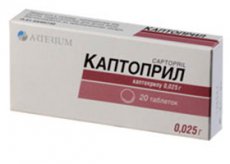Medical expert of the article
New publications
Preparations
Captopril
Last reviewed: 23.04.2024

All iLive content is medically reviewed or fact checked to ensure as much factual accuracy as possible.
We have strict sourcing guidelines and only link to reputable media sites, academic research institutions and, whenever possible, medically peer reviewed studies. Note that the numbers in parentheses ([1], [2], etc.) are clickable links to these studies.
If you feel that any of our content is inaccurate, out-of-date, or otherwise questionable, please select it and press Ctrl + Enter.

Indications Kaptoprila
It is used mostly to prevent the development of hypertensive crisis and lower blood pressure values. Used for these disorders:
- increased pressure inside the kidneys;
- primary hypertension (increase in blood pressure values, which has an unknown nature);
- malignant hypertension (in the presence of resistance to other drugs).
 [7]
[7]
Release form
The release of the element is made in tablet form (volumes 12.5, 25, as well as 50 or 100 mg). Inside the cell packs - 10 tablets. In the box - 2 packs.
Pharmacodynamics
The active component of the drug slows down the activity of ACE, which prevents the transformation of angiotensin-1 in the 2nd form. Angiotensin-2 is the main element of the structure of the RAS, which has a significant vasoconstrictor effect. A decrease in angiotensin-2, a decrease in the production of aldosterone, and besides this, the cumulation of the vasodilating element bradykinin leads to the development of antihypertensive activity.
Captopril reduces systemic vascular resistance relative to blood flow, weakens pressure and afterload inside the small circle of blood flow. At the same time, the drug may further reduce the aldosterone values inside the adrenal glands.
Pharmacokinetics
Approximately 75% of the active element at a fairly high speed is absorbed inside the gastrointestinal tract. Eating can reduce the degree of absorption by 30-40%. Blood indices Cmax are determined after 0.5-1.5 hours. The synthesis of the active ingredient with albumin is 25-30%.
Captopril is excreted with breast milk. Exchange processes take place inside the liver. Metabolic products have no medicinal activity.
Excretion of 95% of the drug is carried out by the kidneys (almost half of them are in an unchanged condition, and the remainder is in the form of metabolic products).
In individuals with severely impaired renal function, there is an accumulation of the drug.
Dosing and administration
The medication is required to be taken orally. The substance quickly reduces blood pressure. Prescribe medication can only treating the doctor.
With the development of hypertensive crisis, it is required to put a pill with a dosage of 25 mg under the tongue - this leads to the rapid development of antihypertensive effects.
Use Kaptoprila during pregnancy
It is forbidden to use in pregnant women or during breastfeeding.
Contraindications
Main contraindications:
- aortic narrowing;
- Conn's syndrome;
- mitral constriction;
- condition after kidney transplantation;
- renal artery stenosis;
- tendency to the formation of puffiness;
- the presence of strong sensitivity to the drug;
- myocardiopathy.
Side effects Kaptoprila
The use of a therapeutic substance may provoke the appearance of separate adverse symptoms:
- NA lesions: dizziness, severe fatigue, paresthesias, asthenia, and migraine headaches;
- disorders affecting the work of the cardiovascular system: orthostatic collapse or increased heart rate rhythm;
- disorders of the digestive function: pain in the area of epigastria, nausea, stool disorders (constipation or diarrhea syndrome), a violation of taste buds, and in addition cholestasis, pancreatitis, an increase in AST, ALT or bilirubin and hepatitis;
- problems with the work of the hematopoietic system: anemia, agranulocytosis (if an autoimmune disease is present), neutropenia and a decrease in the number of platelets;
- metabolic disorders: acidosis or increased K + values;
- urinary disorders: the appearance of protein inside the urine and problems with renal function;
- signs of allergy: the presence of antinuclear antibodies, serum sickness, bronchial spasm, lymphadenopathy, or Quincke edema;
- Other: may have a cough of an unproductive dry nature.
If the patient has other negative manifestations, you should consult with the doctor and for a while refuse to use the drug.
Overdose
With drug poisoning, a significant decrease in blood pressure indicators occurs. Violation may be complicated by disorders of the blood supply to the brain, thromboembolism, and myocardial infarction.
In case of such disorders, it is necessary to lay the victim horizontally and lift his legs. Also to restore the values of blood pressure perform intravenous injection of physiological fluid. The peritoneal dialysis procedure will be ineffective, but hemodialysis may produce positive results.
Interactions with other drugs
When administered together with immunosuppressants or cytostatics, leukopenia may occur.
Combination with diuretic substances (potassium-sparing) can cause hyperkalemia (spironolactone and amiloride with triamterene).
Azathioprine can cause anemia associated with the suppression of erythropoietin. There is information about the development of leukopenia caused by additive hematopoiesis within the bone marrow.
When combined with allopurinol, potentiation of hematological properties is possible.
Aspirin can reduce the antihypertensive effect of the drug.
The drug has the ability to increase the indices of digoxin. Most drug interactions develop in individuals with severe renal disease.
Attention!
To simplify the perception of information, this instruction for use of the drug "Captopril" translated and presented in a special form on the basis of the official instructions for medical use of the drug. Before use read the annotation that came directly to medicines.
Description provided for informational purposes and is not a guide to self-healing. The need for this drug, the purpose of the treatment regimen, methods and dose of the drug is determined solely by the attending physician. Self-medication is dangerous for your health.

